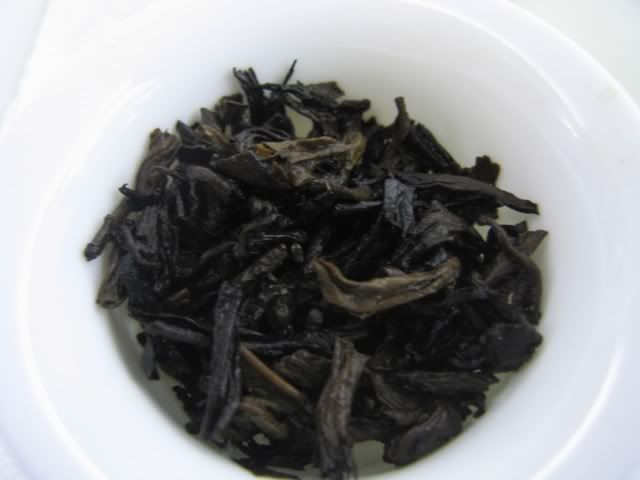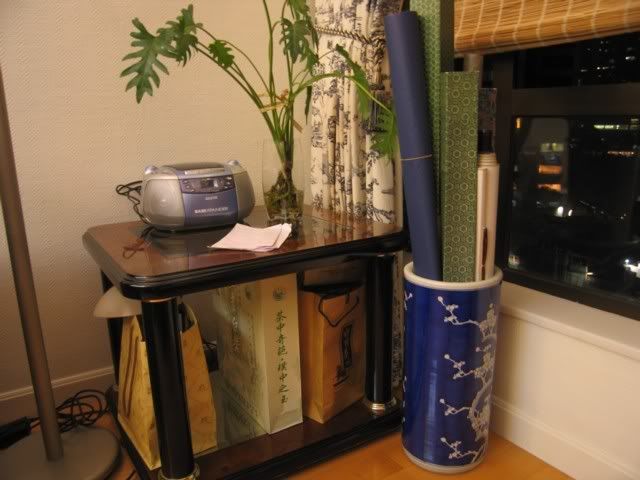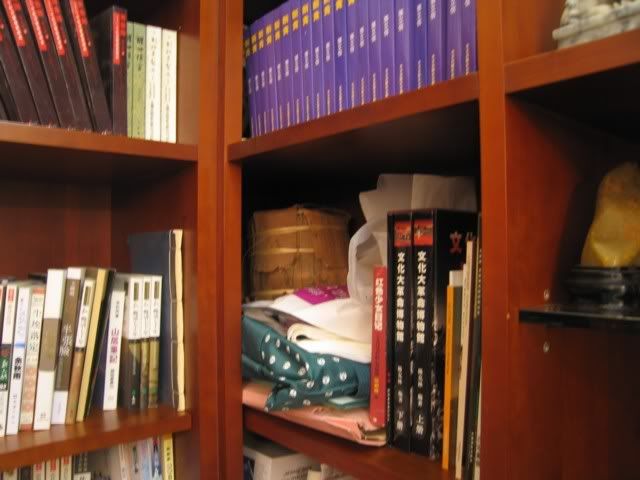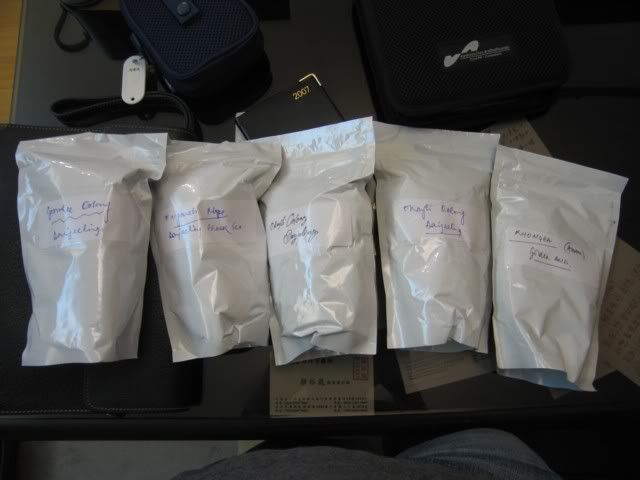I went to drink tea with L again today, who has a shop in Maliandao and a vast array of friends. Everytime I go out with him I’m meeting someone new, which is quite interesting in and of itself.
When I got there they were drinking some cooked pu, with one person looking to buy stuff at the shop. Since they were busy, I walked out with L and one of his friends, S, to look at some teapots. While there (mostly crap) I also saw some interesting cakes…. but wow, they were expensive.
Back in the store, we started drinking tea. I pulled out the tea that I brought along. It was an Ying Kee Teahouse loose puerh, quite cheap (around $250-300 HKD for 600g, if I remembered correctly). It’s wet stored stuff, but ok as a drink it now thing. We had it… and everybody was wondering what it was, and how much it was, etc. This is stuff that is rare in Beijing. However, L’s business partner told me that where she used to work, they also sold a tea that was similar, for something like 1200 RMB/500g…. wow, they’re charging a lot. In fact, I’m sure right now you could sell this tea for just as much here in Beijing. The taste is plain, but pleasant, and easy to drink. You can really fool a lot of people with this stuff.
Then we tried a dizzying array of raw teas as some more friends walked in (and out). It included a Nannuo (ok, but expensive), a Yiwu (not really Yiwu, I think), a Fengqing tuo from 99 (decent). At one point, there were 10-12 people sitting around the table drinking tea, which is rare for any store on Maliandao on any day. None of us were actually going to buy anything, of course, and having a whole bunch of people around the table ensures that no business will be done, because nobody interested in buying tea will walk into a store full of customers already. Nevertheless, Chinese businesses tend to think that the “qi” from people is a good thing. There’s nothing worse than a store that is perpetually empty (which most stores on Maliandao seem to be).
We had dinner (Fujian fare), and then went to a new store that just opened that sells lots of old teas.
This is probably the weirdest store that I’ve been to on Maliandao. It’s nicely decorated (a growing trend, it seems). It’s got lots of old tea. It’s expensive. The woman who seems to own or operates the store is the polar opposite of how the store looks. She looks like an old aunt from a rural village. She is slightly crude in her manners, and worst of all, not too well informed about her tea. When we commented on a few things (ZH is around) she doesn’t always seem to know what we’re referring to. The one thing she keeps repeating is “I have lots of this tea! I have lots of this tea! Aren’t they all clean and in great condition?”. She keeps telling us about her great storage facilities and how clean they are. It’s in Xinjiang, the NW part of China that is largely arid, and she says she keeps a few workers there to clean the facilities constantly. She basically transports teas from Hong Kong and Guangzhou to Xinjiang to let them lose the wetter storage flavour before sending them back to the equally beautifully clean storage in Beijing. Ok, got it.
Well… we tried two things there before I left. The first is a 99 Xiaguan iron cake. Nice flavours, reminds me of the Fengqing tuo that we had earlier today. Teas from that area all broadly taste similar. Good storage condition, nothing too remarkable. I didn’t ask how much, but it probably wasn’t going to be cheap.
The second thing…. she asked us to pick something. Nobody wanted to, so I did the honours and picked a 80s Zhongcha Traditional Character (8653) cake. I wanted to compare it with the sample YP gave me and see how it’s like…. Wow, what a difference. YP’s is so, so, so much better. The cakes look very similar in shape, compression, condition, etc. In fact, I’d say that looking at the teas, there’s almost no difference (except that this cake is whole whereas YP’s is partially drunk). This cake you can’t smell anything, while with YP’s you can smell some tea taste. The liquor also looked similar — the same dark amber hue, very alluring, very nice. Then I lifted the cup to my mouth, poured the tea in, and swished it around…. and I was very disappointed.
I couldn’t find the nice aromatic taste, the sweet, very sweet huigan, and the general smoothness that is present in YP’s tea. Instead, this one was a bit harsh. It’s obviously aged, about 15-20 years I think (she claims 30, but Traditional Character is no older than 1980, I think). The tea is not that aromatic, almost a bit bland given the age, and the body, while thick enough, was not very smooth. It roughs up your tongue, and dries out your throat. There were lots of things that didn’t seem quite right with the tea. I was hoping it would improve with a few more infusions, but it only got worse. Why?
I think I have a theory…. I asked the lady if the storage facilities are well ventilated. To her, it probably sounded like a compliment… but it’s not. She said, proudly, that unless there was a storm, all the windows and doors of the storage are open, usually. The Beijing facilities boast of powerful floor fans that blow a steady and strong breeze through the storage at all hours. This all in the name of “tuicang”, or “receeding storage”, i.e. the process that you do by leaving wet-stored tea in a dry storage facility to let it lose the wet-stored taste. It all sounds good in theory…. but I think she got it wrong. I am by no means an expert, but from what I have gathered from reading, and from what I can imagine, a too-well-ventilated storage area for tea is actually bad for it. The main reason is that the aromatic substances in a tea will dissipate quickly if it’s too well ventilated. On Sanzui you sometimes hear people asking for help, because they put their tea in a breezy corridor and now they are bland. I think this is why the Zhongcha cake is so bland in comparison — the flavours are blown away by the too-well ventilated air.
The other problem, the dryness, is probably also caused by the air movement. Both Xinjiang and Beijing are very dry places. While this might sound like a good idea for storing teas that have been through wet storage, if you have a constant breeze that blows through the tea, then it is constantly bringing very dry air through the tea — sucking away moisture in the tea. Not only will it age poorly while sitting in said storage, it will dry the teas out and also cause the rough/dryness that I felt in the tea. By trying too hard, she might be ruining a lot of good teas.
This is all mere speculation, but most of the stuff I’ve read and heard (from people with experience) all point to the same thing. Tea is best stored in an enclosed area with little to no circulation of air, to keep in the tea’s aroma. It doesn’t have to be extra dry or wet — just average, normal, and natural. It’s a pity that her teas might all be messed up eternally given how they are treated. Sure, they look great, and look like perfectly dry stored stuff, but when it hits your mouth…. it’s just not the same. I will pay $600 for YP’s cake, I will not pay $600 for this woman’s. Besides, her prices are easily double that of Hong Kong. Forget it.
Wow, this was a verbose entry.








 RSS - Posts
RSS - Posts
Interesting.... would 250C in my oven work?